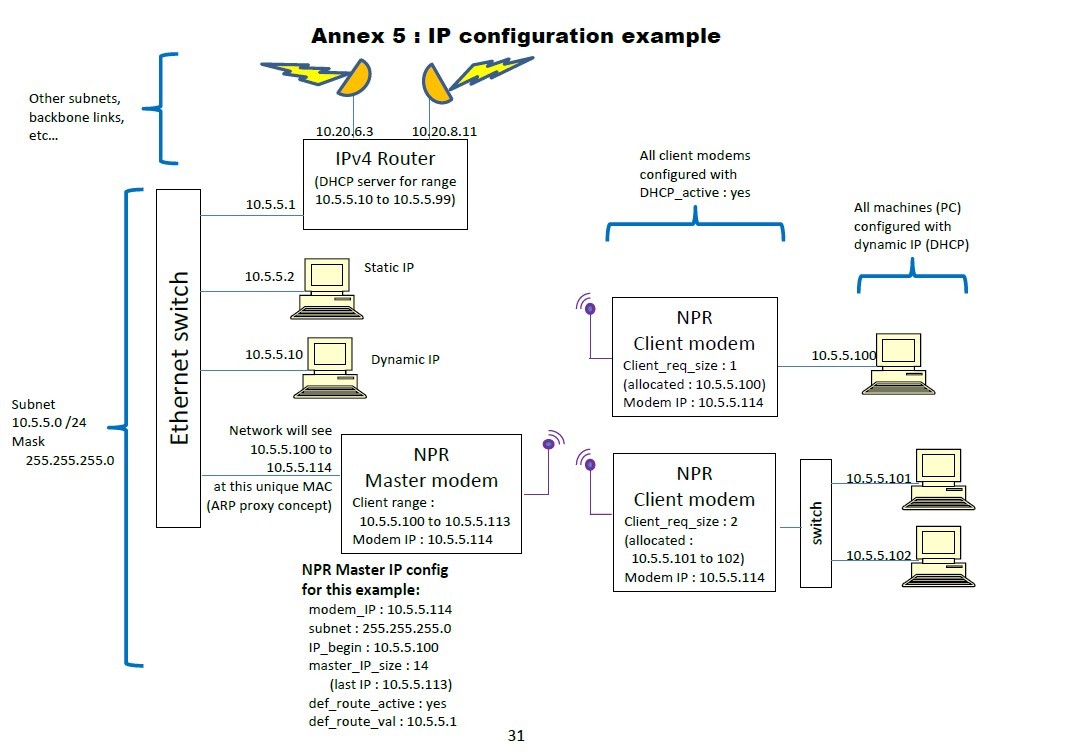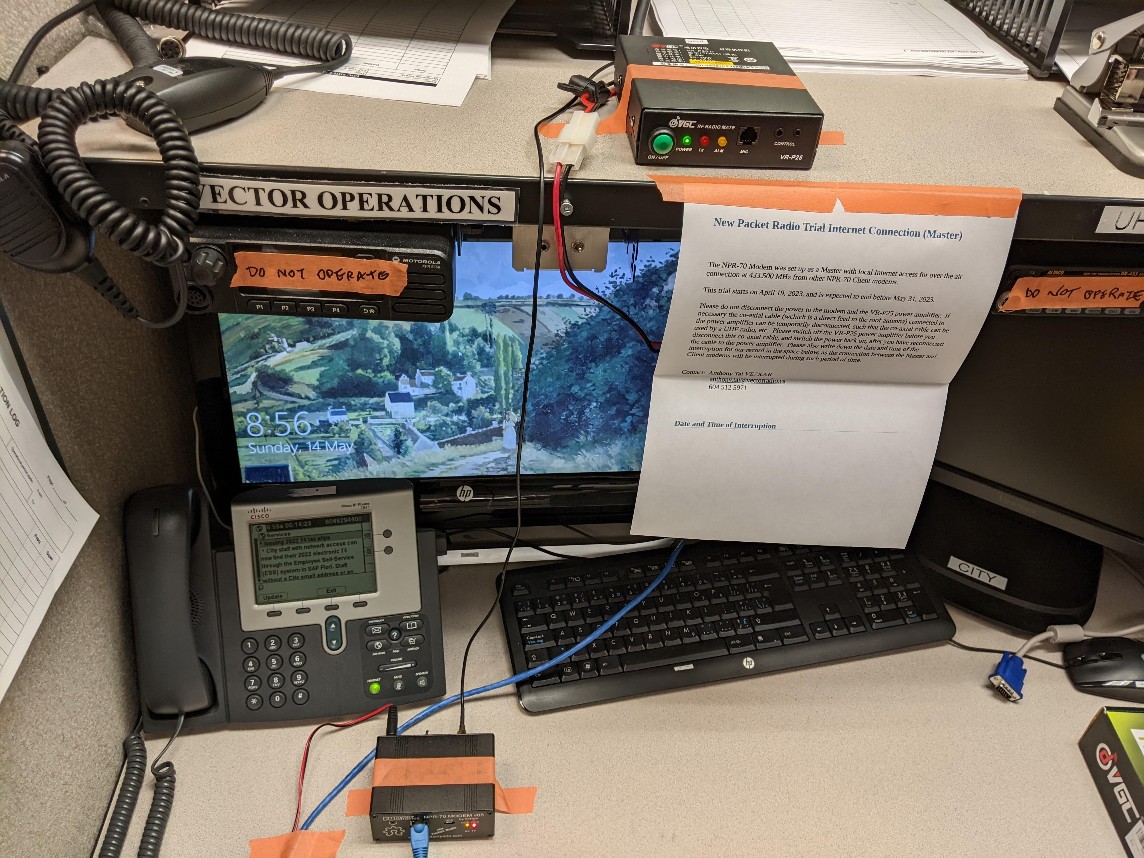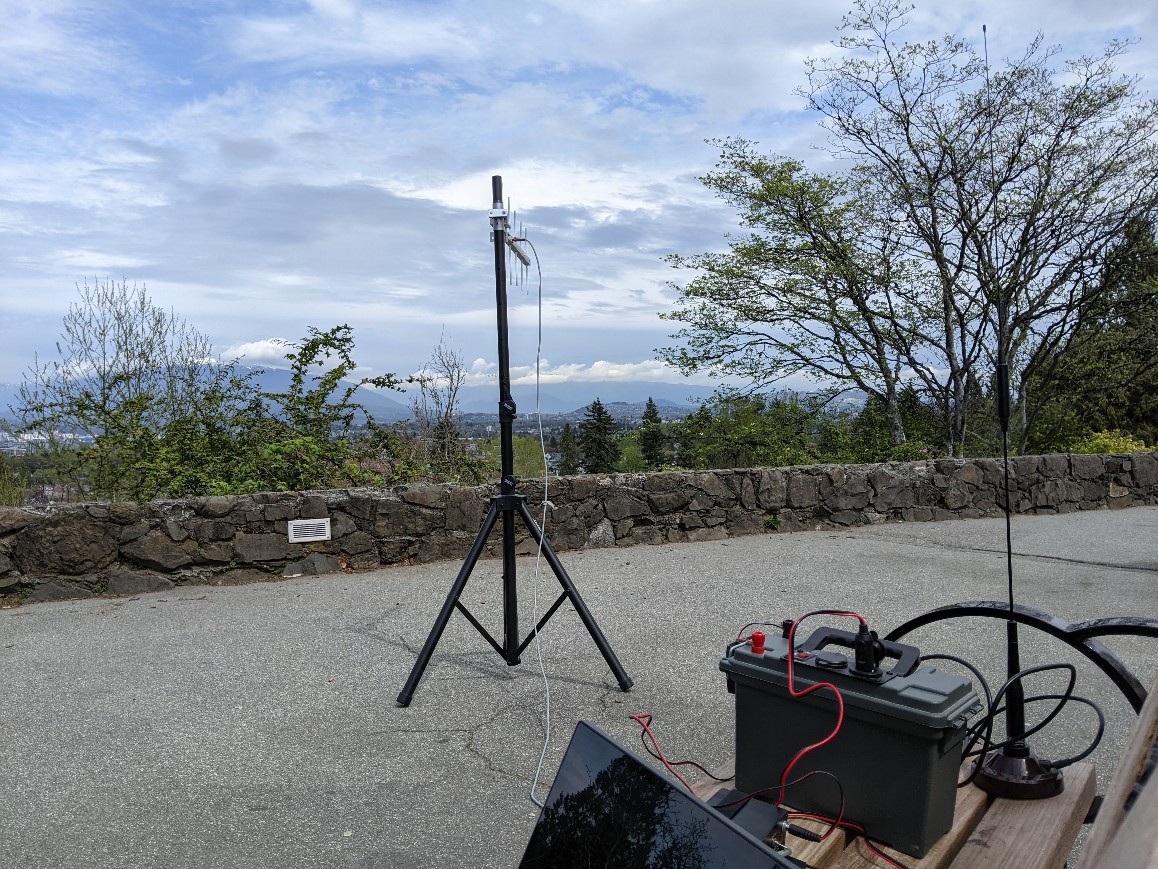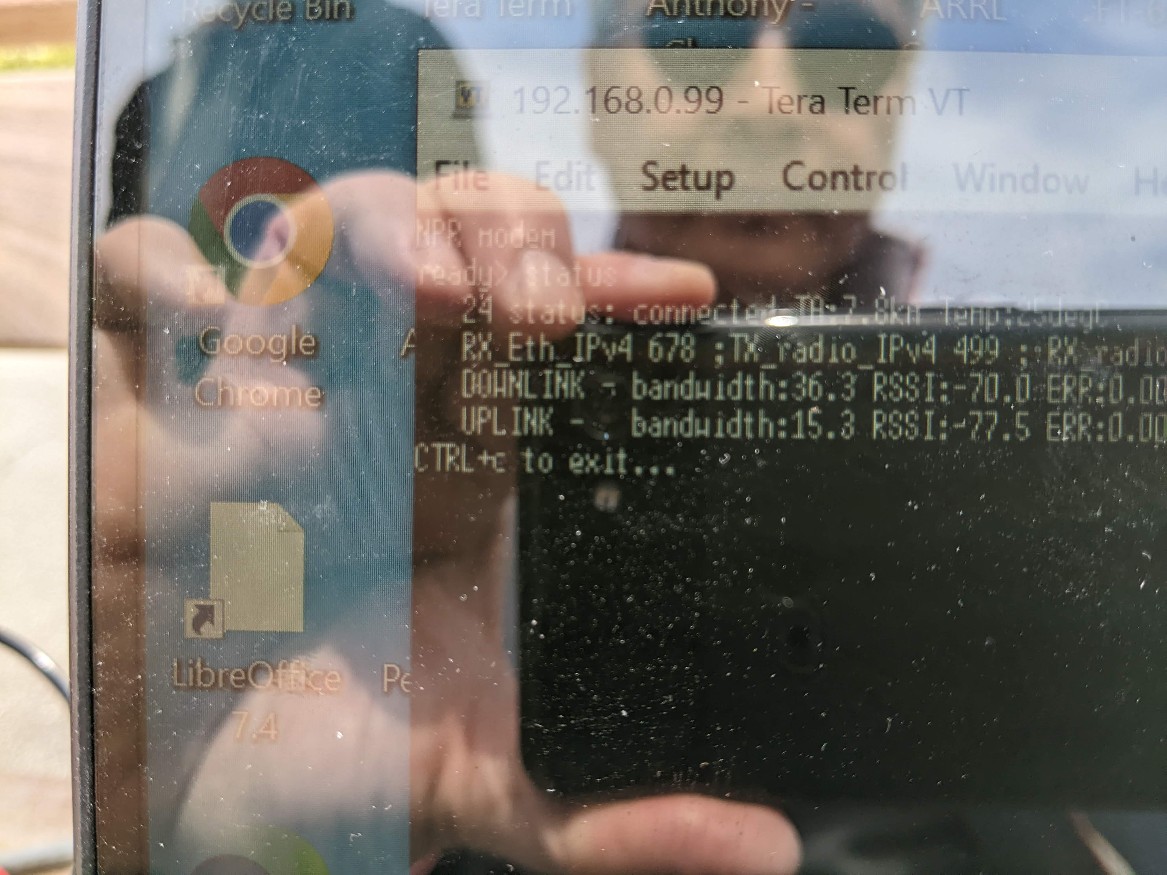New Packet Radio Trial Internet Connection - 2023 March
Posted in news; tagged with news, projects, tech
Last year, we evaluated how well New Packet Radio would work on our 0.7 cm band.
Winlink email with an 85 kB DFU file took 20 seconds over NPR at Modulation Mode 11 from field to GMail (through the EOC and Winlink Global Email system via Telnet). Winlink reported 156 kB per minute.
The same 85 kB file takes much longer over 1200 packet; 30 minutes at 3.3 kB/min to send with 1200 packet over radio with the RMS radio in the same room, or 4 minutes at 22 kB/min with 9600 packet (or less than 1 second at 746 kB/min with Telnet over 100 Mbps Ethernet).
Feasibly send large file attachments with Winlink (message size limit is 120 kB).
Mode 11 needed very strong signal to get 0% bit error rate (better than -80dBm).
We set up an NPR-70 Modem as Master with local Internet access for over-the-air connection at 433.500 MHz from other NPR-70 Client modems. We ran the trial from April 19, 2023, to May 31, 2023.
The setup included a VR-P25 power amplifier connected on the feed to the roof antenna.
VECTOR New Packet Radio (NPR) Trial
Summary
-
New Packet Radio (NPR) is a 2019 development by Guillaume (F4HDK). It is not related to the AX.25 packet for amateur radio. NPR website: https://hackaday.io/project/164092
-
The NPR-70 modem is a TCP/IP router-like device put together with open source boards for the respective processing/control, transceiver, and networking functions. This device can support transfer rates from 50 kbps to 500 kbps of IPv4 traffic. The NPR protocol supports Time Division Duplex similar to DMR, in either simplex or hybrid full duplex for point-to-point or point-to-multi point configurations. A RF power amplifier can be used to boost the output from the modem which is only 0.5 W.
-
The use of the 70 cm amateur band provides more choices of antenna and RF path options, compared with 2.4 or 5 GHz.
-
In June 2020 the VECTOR board approved funding for a trial proposed by Francois Marier (VA7GPL), to study the feasibility of linking DSA’s to the EOC at E-Comm using NPR.
-
The writer (VE7XAK) began to participate in the trial from November 2020. Several tests were made between VA7GPL’s residence in the downtown area and the EOC, as well as the Spanish Bank Beach. The results were unsuccessful due to insufficient signal strength and excessively high bit error rates. Link connection between the master modem and the client modem could not be consistently established and maintained.
-
In April 2021, VA7GPL had to scale back activities with VECTOR due to personal reasons. The trial was suspended until April 2023, when VE7XAK resumed the trial. Several tests were made between the EOC (Master end with Internet connection), the Queen Elizabeth Park and the Spanish Banks beach as Client end locations.
-
Limited success was achieved at the QE Park (7.8 km from the EOC), where a maximum throughput of 26 kbps was recorded in Telnet Winlink file upload (compared with 0.6 kbps in 1200, or 3.7 kbps in 9600 Packet Winlink). The throughput was highly dependent on bit error rate, which was very sensitive to RF interference even with a high S/N ratio. It was not possible to maintain a consistent connection from the Spanish Bank site (14.2 km from the EOC) due to lower than required signal strength.
-
The transceiver board inside the modem was quite susceptible to RF interference such as desensitization, multi path and inter modulation distortion. It is due to very limited on board filtering and wide band characteristic of the transceiver chip (Silicon Labs Si4463).
-
Based on results of the trial, the NPR modem is not recommended for DSA to EOC connection. It is more suitable for direct line-of-sight (or very near line-of-sight) applications with directional antennas where signal strength and interference can be optimized.
-
There has been no further development or news from F4HDK since 2021. The last firmware update for the modem was in 2020.
Trial Setup in April 2023
-
At the EOC, one NPR-70 modem was configured as Master, connected to a VR-P25D power amplifier (approx 15 W with 0.5 W input), and then directly to the CX333 antenna at Station 2. Ethernet port of the NPR-70 was connected to the TRENDnet TEG240WS switch in the backroom, and became part of the IP subnet of the switch which is connected to a public Internet service.
-
Another NPR-70 modem was configured as Client, connected to a VR-P25D power amplifier, and then an Arrow 440-5S Yagi antenna. Ethernet port of the NPR-70 was connected to a laptop computer running Winlink Express.
-
A third NPR-70 also with VR-P25D was configured with either a Master or a Client, to simulate conditions with either two Master or two Clients on the same RF frequency but with different, or the same network ID.
Configuration example provided by F4HDK – The IP addresses used in the trial were of course different from this example, but the idea is to set up an IP address pool at the Master which is different from the ones in use by other devices connected to the switch, and then allocate IP addresses in the pool to Clients which also act as DHCP servers for the computers connected to them.


Test set up at the EOC Station 2.
F4DHK recommends daily reboot of the modem but the set up remain stable for the 3 weeks trial period without a reboot.

Test set up at the Queen Elizabeth Park.
Connection with the Master could not be established with Modulation Mode 22 (max 220 kbps). Changing to the more robust Mode 11 (max 71 bps) resulted in successful file uploads using Telnet Winlink. The mag mount antenna could not provide sufficient signal strength to establish a connection.

Maximum RSSI reading was -77 with 0% bit error rate. While signal strength was sufficient with a Yagi, bit error rate rose to double digits with just a turn of 15 degrees from the optimal direction pointing towards the EOC.
Test set up at the Spanish Bank.
Connection with the Master could not be established except for a few make-and-drop cases when the antenna was pointing at a certain direction towards Mount Fromme, likely receiving the strongest, reflected signal from the EOC. At this location connection with 1200 bps Packet Winlink using a Kenwood TH-D72A and stock antenna is always possible.
Notes on Winlink File Transfer Speeds
-
During the trial a 85 kB DFU file was attached to a Winlink message and then sent to a Gmail account through the Winlink Global Email system via Telnet. The time it took for sending the message with the attachment was between 15 to 20 seconds for NPR at Modulation Mode 11, at 156 kB/min as reported by Winlink.
-
For comparison the same 85 kB file would take 30 minutes at 3.3 kB/min to send with 1200 packet over radio with the RMS radio in the same room, or 4 minutes at 22 kB/min with 9600 packet, or less than 1 second at 746 kB/min with Telnet over 100 Mbps Ethernet.
-
This shows the time it takes to send a large file attachment with Winlink (message size limit is 120 kB) makes it impractical to send over 1200 packet, but more feasible with 9600 packet or NPR.
Notes on RSSI and Signal Strength
-
According to Silicon Labs, the Si4463 reports RSSI values in dB, which can be directly translated into dBm with a calibrated value. The RSSI values reported by the modems are without units but seems to correspond to dBm based on the receiver conditions during the trial.
-
According to F4HDK, a received signal strength of -95 dBm is required to achieve 0% bit error rate in Modulation Mode 22 (Mode 11 is not documented). This is 2 dB more than a S9 reading on a VHF/UHF radio. During the tests it took considerably stronger signal (e.g. better than -80 dBm) to achieve 0% bit error rate in Mode 11.
Master Modem Configuration at the EOC
callsign: ‘VA7VCT’
is_master: yes
MAC: 4E:46:50:52:0A:61
ext_SRAM: yes
frequency: 433.500MHz
freq_shift: 0.000MHz
RF_power: 120
modulation: 11
radio_netw_ID: 10
radio_on_at_start: yes
telnet_active: yes
telnet_routed: yes
modem_IP: 192.168.0.100
netmask: 255.255.255.0
master_FDD: no
IP_begin: 192.168.0.100
master_IP__size: 9 (Last IP: 192.168.0.108)
def_route_active: yes
def_route_val: 192.168.0.1
DNS_active: yes
DNS_value: 192.168.0.1
Client Modem Configuration
callsign: ‘VE7XAK’
is_master: no
MAC: 4E:46:50:52:D8:9A
ext_SRAM: yes
frequency: 433.500MHz
freq_shift: 0.000MHz
RF_power: 120
modulation: 11
radio_netw_ID: 10
radio_on_at_start: yes
telnet_active: yes
telnet_routed: yes
modem_IP: 192.168.0.100
netmask: 255.255.255.0
IP_begin: 192.168.0.105
client_req_size: 1
DHCP_active: yes
Prepared by Anthony Tai (VE7XAK) 2023-05-23